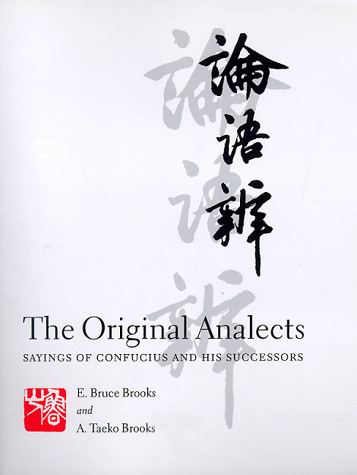Introduction
Early History
Following Chinese custom, the history of the Project before it became the Project, and during its first five years of operation as the Project, was sketched in the Afterword to The Original Analects (Columbia 1998). Here is another account of those years.
The orthodox view was that the Analects was the work of Confucius and his immediate disciples. Doubts about this scenario go back to Han Yw's protégé Lyou Dzung-ywaen in the late Tang dynasty. Hu Yin, in Sung, openly suggested that the work might have more than one layer; he suggested a split between LY 1-10 and 11-20. Tswei Shu, in the Ching Dynasty, further divided Hu's second layer, making LY 16-20 significantly later than the rest of the work. His results, largely unpublished in his lifetime, were rediscovered in the 20th century. Arthur Waley, in his 1938 English translation, ignoring these results but taking his own view of the matter, regarded the Analects as consisting of two portions, an early LY 3-9, and a "perfectly consistent" later segment, LY 1-2 plus 10-20. Some readers were disposed to regard Waley's LY 3-9 core as a further refinement of the Hu early layer, leading to a four-layer view of the text. And there matters stood.
In preparing some Analects passages for classroom use, in the 70's, it became apparent that not only the Analects, but other early texts as well, were complex. A 1979 grant from the American Council of Learned Societies with funding from the National Endowment for the Humanities, focused on the Jwangdz, and concluded that its problems were not soluble without reference to the Warring States text problem as a whole, and that the Analects, with its great time depth, was the key to that problem. The critical discovery, that anomalies in the Analects could be resolved by a hypothesis of accretional growth complicated by a parallel interpolation growth, was made on 27 April 1980. That discovery was extended in subsequent years into an integrated chronology embracing at least portions of most of the major Warring States texts. The fact that such a chronology could be reached without mutual contradiction suggested that these results on the Analects and other texts were generally in the right direction.
Discussions over the period 1976-1987 with David S Nivison, Victor Mair, F W Mote, Joseph F Fletcher Jr, and other colleagues exposed the theory to criticism from various points of view. Several footnotes in David Nivison's 13 February 1984 Evans-Wentz lecture constitute, so far as we know, the first scholarly reference to our findings. Various implications of the work were presented for criticism in annual talks during 1984-1993 to the Colloquium Orientologicum of the University of Massachusetts at Amherst, presided over by Alvin P Cohen. Conversations at the annual meetings of the New England Symposium on Chinese Thought beginning in 1988 were also fruitful, and a 19 May 1990 paper on the Analects / Dau/Dv Jing relationship for the Symposium received a helpful response. On 11 June 1993, Dean Lee R Edwards of the College of Humanities and Fine Arts of the University of Massachusetts at Amherst authorized, and Professor Alvin P Cohen subsequently coordinated, an interuniversity Warring States Working Group, which from its first meeting of sixteen persons on 9-10 October 1993, on three occasions with support from the Committee on China and Inner Asia of the Association for Asian Studies, provided a semiannual forum for the criticism and development of the chronology and its historical interpretation. The Analects was included among the texts treated in a long review article, The Present State and Future Prospects of Pre-Han Text Study (1994), offering an opposition view to the consensus represented by Loewe, Early Chinese Texts (1993). Other presentations of the theory to the field included a panel proposed by Paul Ropp at the New England regional meeting of the Association for Asian Studies on 15 October 1994, with Kidder Smith as moderator and Karen Turner and David N Keightley as discussants; and a panel on Developmental Aspects of the Warring States for a subsequent meeting of the New England AAS in Amherst on 28 October 1995, with Dennis Grafflin, Constance A Cook, and Karen Turner as co-participants. Thanks are here renewed to all concerned.
Our further study of the linguistic evidence culminated on 15 October 1993 in a revision of what we regarded as the extent of the original LY 4 core, and a Warring States Working Group exchange with David Nivison on the date of the Chi Kingship led on 14 September 1996 to an adjustment of the date previously assigned to LY 3. Lecture audiences at the Universities of North Carolina and Pennsylvania, Bates College, and Harvard, Brown, Indiana, and Columbia Universities during the years 1993-1997 raised a number of other provocative questions. A 1996-1997 fellowship from the National Endowment for the Humanities supported continued research on the larger problems of Warring States text chronology. On 29 October 1996, a partial version of the translation was read and criticized, by twenty members of the Warring States Working Group. Final choices were made among the sometimes opposed suggestions received on that occasion, and the text went into final editing at Columbia University Press.
One morning in February 1998, the postman brought the author copies of the published work to the authors' front porch. Holding one of them, Taeko remarked, "So much of my life is in that little space."
All materials on this site are Copyright © 1993 or subsequently by the Warring States Project or by individual authors
